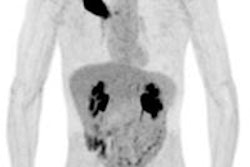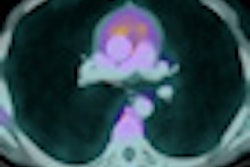While no imaging or invasive procedure is foolproof for staging non-small cell lung cancer (NSCLC), Danish researchers have found that PET/CT is more accurate than CT alone, though both modalities had a tendency to understage and overstage the cancer.
In addition to examining the efficacy of CT and PET/CT in staging, the study also assessed the staging capabilities of mediastinoscopy and endoscopic ultrasound-guided fine-needle aspiration (EUS-FNA) for point of reference. The ultimate goal is to determine whether PET/CT can play a role in radiation therapy planning by providing an accurate description of the mediastinum.
"Apart from staging distant metastases, accurate staging of the mediastinum is of primary importance when deciding whether or not a patient with lung cancer is a candidate for surgery," said lead study author Barbara Fischer, MD, from Hvidovre Hospital in Hvidovre, Denmark. "The accurate staging of the mediastinum is mainly based on the ability of PET/CT to discriminate between mediastinal disease."
Fischer presented the research in June at the SNM annual meeting in Salt Lake City.
Mediastinum staging
Staging the mediastinum is based on the localization of lymph nodes and the ranking of the extent of cancer from 0 for no sign of mediastinal disease to 3, indicating that cancer has spread to lymph nodes in the upper mediastinum and contralateral to a primary tumor.
The researchers enrolled a total of 189 patients with NSCLC in the study. The patients were randomized into the PET/CT group (98 patients) and a conventional workup group (91 patients).
In the PET/CT group, 74 patients also underwent mediastinoscopy and 36 patients received EUS-FNA. In the conventional workup group, 86 patients received mediastinoscopy and 30 patients underwent EUS-FNA. Fourteen patients were later excluded from the PET/CT group after declining to participate in the staging procedures.
A pulmonologist and a surgeon assigned a consensus N-stage rating. Their N-stage evaluations then were compared to final N-stage designations determined either by surgery or a conclusive invasive test.
Staging analysis
In the analysis, the researchers found that CT alone was correct in its N-stage assessment in 49% of the patients, while the modality understaged 15% of the cases and overstaged 36% of them. "Thus, the agreement with final N-stage was not very impressive," Fischer concluded.
PET/CT assigned the correct N-stage in 58% of the patients, understaged 24% of the cases, and overstaged 18% of the cases. PET/CT "was still not very impressive with final [N-stage] agreement," she added, "but it was more accurate in final agreement with N-stage than CT" alone, and there was a "significant reduction in the frequency of overstaging" with PET/CT.
Mediastinoscopy achieved the correct N-stage in 61% of patients, but it understaged 39% of its cases. EUS-FNA produced the correct N-stage in 81% of patients and understaged 19%.
"Of the invasive measures, overstaging cannot occur as these results will be final and cannot be overcalculated," Fischer said. "Surprisingly, we found understaging by mediastinoscopy, which is often assigned as the gold standard. EUS-FNA appears to be the more accurate staging reference, being accurate in 81% of our patients, but, surprisingly, understaging 19% of our patients."
N-stage consensus
The consensus N-stage assessment by the pulmonologist and surgeon was correct for 80% of the patients in the PET/CT group and 69% in the conventional workup group. "The difference was not statistically significant," she added, "but there was a trend toward more accurate N-staging in PET/CT."
In conclusion, the researchers found that PET/CT provides a more accurate description of the N-stage in NSCLC patients than CT alone. While EUS-FNA was the most accurate method to assign an N-stage rating, both EUS-FNA and mediastinoscopy had a high percentage of understaged patients.
Regarding radiation therapy, it is "important to keep in mind that overstaging is significantly more frequent with CT compared to PET/CT, but understaging still does appear with similar frequencies in CT and PET/CT," Fischer said.
Though the study supports the use of PET/CT for radiation therapy planning, she added that it "certainly underscores the need for more clinical studies regarding PET/CT, radiotherapy, and patient outcome."
By Wayne Forrest
AuntMinnie.com staff writer
July 2, 2010
Related Reading
ASTRO: Use PET for NSCLC judiciously, November 3, 2009
PET/CT helps speed lung cancer diagnosis, October 2, 2009
PET/CT beats 3T MRI in whole-body primary tumor staging, March 10, 2008
FDG-PET/CT aids in radiation therapy planning, March 5, 2008
PET/CT planning allows for greater gamble on NSCLC radiotherapy, March 16, 2005
Copyright © 2010 AuntMinnie.com



















